Rayong
ระยอง | |
|---|---|
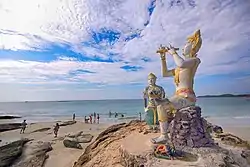 The statues of Phra Aphamani and the mermaid, characters from a famous Thai epic poem, on Ko Samet | |
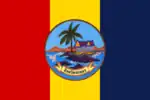 Flag 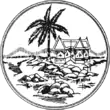 Seal | |
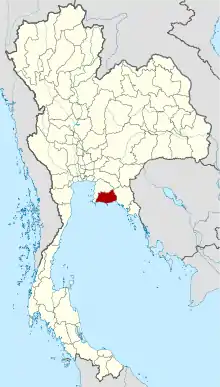 Map of Thailand highlighting Rayong province | |
| Country | Thailand |
| Capital | Rayong |
| Government | |
| • Governor | Channa Iamsaeng (since October 2020) |
| Area | |
| • Total | 3,552 km2 (1,371 sq mi) |
| • Rank | Ranked 57th |
| Population (2018)[2] | |
| • Total | 723,316 |
| • Rank | Ranked 35th |
| • Density | 203.6/km2 (527/sq mi) |
| • Rank | Ranked 14th |
| Human Achievement Index | |
| • HAI (2017) | 0.6578 "high" Ranked 8th |
| GDP | |
| • Total | baht 985 billion (US$34 billion) (2019) |
| Time zone | UTC+7 (ICT) |
| Postal code | 21xxx |
| Calling code | 038 |
| ISO 3166 code | TH-21 |
Rayong province (Thai: ระยอง, pronounced [rá.jɔ̄ːŋ]) is one of seventy-six provinces (changwat) within Thailand, and lies in eastern Thailand. The province is bordered by Chonburi to its west and north; Chanthaburi to its east; and the Gulf of Thailand to its south.[5]
As of 2016, per capita earnings were higher in Rayong province than in any other Thai province.[6]
History
Rayong began to appear in 1570 in the reign of Maha Thammaracha, The Khmer Ruler has invaded Siam in the eastern coastal city but unable to seize the city.
Following the fall of Ayutthaya to the Burmese during the Burmese–Siamese War, the future king of the Thonburi kingdom, Taksin, arrived in Rayong. In Rayong, Taksin built a new navy before going on to Chanthaburi to assemble forces to fight the Burmese. Taksin then passed back through Rayong during the reunification of Siam as the Thonburi kingdom. The oldest temple in Rayong, Wat Pa Pradu, is dedicated to Taksin where locals worship his spirit.[7]
In 1906, Rayong was merged to Monthon Chanthaburi. In 1908, Klaeng district was merged to Rayong.
In the reign of King Rama VI, changed the name of "Rayong City" to "Rayong province" in 1916 but it still part of Monthon Chanthaburi. Later in 1931, Monthon Chanthaburi was dissolved and Rayong was merged to Monthon Prachinburi.
Geography
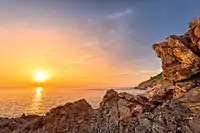
Although the north is hilly, the province consists mostly of low coastal plains. The total forest area is 292 km2 (113 sq mi) or 8 percent of provincial area.[8] Off the shoreline of Mueang Rayong District is Khao Laem Ya–Mu Ko Samet National Park, consisting of several islands.
National parks
There are two national parks, along with five other national parks, make up region 2 (Si Racha) of Thailand's protected areas.
- Khao Laem Ya–Mu Ko Samet National Park, 131 km2 (51 sq mi)[9]: 34
- Khao Chamao–Khao Wong National Park, 84 km2 (32 sq mi)[9]: 13
Symbols
The seal of the province shows the island Ko Samet. The provincial tree is the Alexandrian laurel (Calophyllum inophyllum).
Economy
Rayong is one of the three Thai provinces, together with Chonburi and Chachoengsao, at the center of the nation's Eastern Economic Corridor. The three provinces are to become Thailand's hub for manufacturing, research, and services tightly coupled with its ASEAN neighbors and the world logistically.[10] The project is the centerpiece of the government's "Thailand 4.0" economic initiative.[11][12]
Administrative divisions
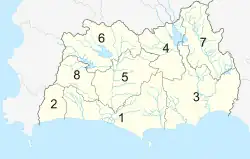
Provincial government
The province is divided into eight districts (amphoes). These are further divided into 58 subdistricts (tambons) and 388 villages (mubans).
Local government
As of 21 November 2019 there are:[13] one Rayong Provincial Administrative Organization - PAO (ongkan borihan suan changwat) and 30 municipal (thesaban) areas in the province. The capital Rayong has city (thesaban nakhon) status. Ban Chang and Map Ta Phut have town (thesaban mueang) status and 27 subdistrict municipalities (thesaban tambon).[2] The non-municipal areas are administered by 37 Subdistrict Administrative Organizations - SAO (ongkan borihan suan tambon).
Health
Rayong's main hospital is Rayong Hospital, operated by the Ministry of Public Health.
Human achievement index 2017
| Health | Education | Employment | Income |
| 16 | 7 | 4 | 9 |
| Housing | Family | Transport | Participation |
 |
 |
 |
|
| 67 | 44 | 6 | 68 |
| Province Rayong, with an HAI 2017 value of 0.6578 is "high", occupies place 8 in the ranking. | |||
Since 2003, United Nations Development Programme (UNDP) in Thailand has tracked progress on human development at sub-national level using the Human achievement index (HAI), a composite index covering all the eight key areas of human development. National Economic and Social Development Board (NESDB) has taken over this task since 2017.[3]
| Rank | Classification |
| 1 - 15 | "high" |
| 16 - 30 | "somewhat high" |
| 31 - 45 | "average" |
| 45 - 60 | "somewhat low" |
| 61 - 77 | "low" |
| Map with provinces and HAI 2017 rankings |
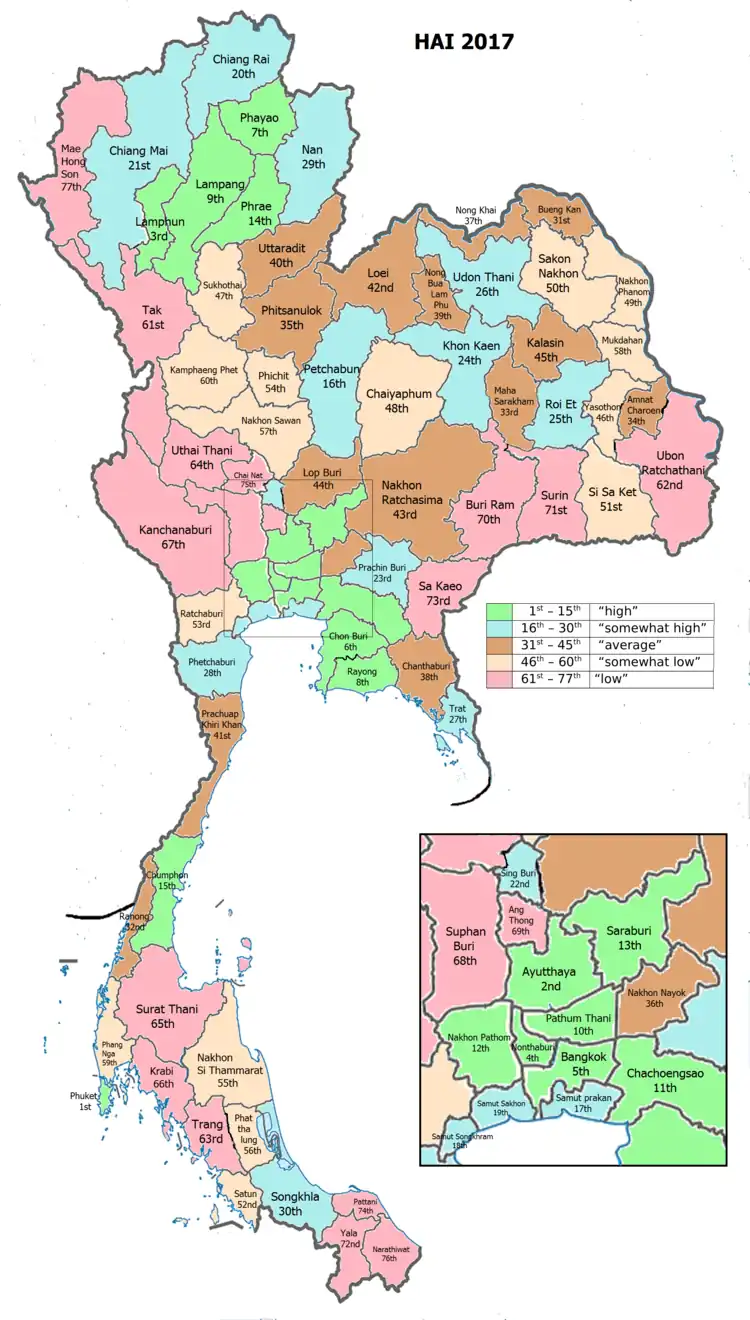 |
Notable People from Rayong province
Gallery
 The cape of Khao Laem Ya in the morning, Khao Laem Ya – Mu Ko Samet National Park
The cape of Khao Laem Ya in the morning, Khao Laem Ya – Mu Ko Samet National Park Khao Laem Ya – Mu Ko Samet National Park
Khao Laem Ya – Mu Ko Samet National Park Khao Laem Ya – Mu Ko Samet National Park
Khao Laem Ya – Mu Ko Samet National Park Khao Laem Ya – Mu Ko Samet National Park
Khao Laem Ya – Mu Ko Samet National Park Khao Laem Ya – Mu Ko Samet National Park
Khao Laem Ya – Mu Ko Samet National Park Khao Laem Ya – Mu Ko Samet National Park
Khao Laem Ya – Mu Ko Samet National Park Khao Chamao (Khlong Nam Sai) Waterfall, Khao Chamao–Khao Wong National Park
Khao Chamao (Khlong Nam Sai) Waterfall, Khao Chamao–Khao Wong National Park
References
- ↑ Advancing Human Development through the ASEAN Community, Thailand Human Development Report 2014, table 0:Basic Data (PDF) (Report). United Nations Development Programme (UNDP) Thailand. pp. 134–135. ISBN 978-974-680-368-7. Retrieved 17 January 2016, Data has been supplied by Land Development Department, Ministry of Agriculture and Cooperatives, at Wayback Machine.
{{cite report}}: CS1 maint: postscript (link) - 1 2 "ร่ยงานสถิติจำนวนประชากรและบ้านประจำปี พ.ศ.2561" [Statistics, population and house statistics for the year 2018]. Registration Office Department of the Interior, Ministry of the Interior. stat.bora.dopa.go.th (in Thai). 31 December 2018. Retrieved 20 June 2019.
- 1 2 Human achievement index 2017 by National Economic and Social Development Board (NESDB), pages 1-40, maps 1-9, retrieved 14 September 2019, ISBN 978-974-9769-33-1
- ↑ "Gross Regional and Provincial Product, 2019 Edition". <>. Office of the National Economic and Social Development Council (NESDC). July 2019. ISSN 1686-0799. Retrieved 22 January 2020.
- ↑ "About Rayong". Tourism Authority of Thailand (TAT). Retrieved 1 July 2019.
- ↑ "Gross Regional and Provincial Product 2016 Edition". National Economic and Social Development Board (NESDB). Retrieved 2 July 2019.
- ↑ "Rayong and the Exotic Tale of Thai Adventures". www.centarahotelsresorts.com. Retrieved 2 September 2023.
- ↑ "ตารางที่ 2 พี้นที่ป่าไม้ แยกรายจังหวัด พ.ศ.2562" [Table 2 Forest area Separate province year 2019]. Royal Forest Department (in Thai). 2019. Retrieved 6 April 2021, information, Forest statistics Year 2019
{{cite web}}: CS1 maint: postscript (link) - 1 2 "ข้อมูลพื้นที่อุทยานแห่งชาติ ที่ประกาศในราชกิจจานุบกษา 133 แห่ง" [National Park Area Information published in the 133 Government Gazettes]. Department of National Parks, Wildlife and Plant Conservation (in Thai). December 2020. Retrieved 1 November 2022.
- ↑ Dunseith, Bradley (29 June 2018). "Thailand's Eastern Economic Corridor – What You Need to Know". ASEAN Briefing. Retrieved 1 July 2019.
- ↑ "Opportunity Thailand" (PDF). Thailand Board of Investment. Retrieved 1 July 2019.
- ↑ Lopez, Leslie (24 July 2017). "Thai junta aims to make eastern economic hub its legacy". Straits Times. Retrieved 1 July 2019.
- ↑ "Number of local government organizations by province". dla.go.th. Department of Local Administration (DLA). 26 November 2019. Retrieved 10 December 2019.
49 Rayong: 1 PAO, 1 City mun., 2 Town mun., 27 Subdistrict mun., 37 SAO.
External links
 Rayong travel guide from Wikivoyage
Rayong travel guide from Wikivoyage- Provincial Website (Thai)
- Eastern Economic Corridor (EEC) Office